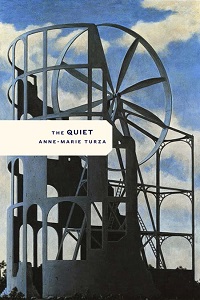
Anne-Marie Turza. The Quiet. Toronto: Anansi, 2014.
~Reviewed by Jean Van Loon
“The job of a house is to have a roof. / The job of a life? It might be anything / made of wood or drift or warning.” So ends “Households,” the opening poem in the second section of this book. From a straightforward declaration, to a metaphor, and then to language that skips—object to movement to emotion—these lines move at a speed that sends my mind spinning. This small excerpt represents just one example of the mastery in this polished first collection.
Three of the book’s five sections form a frame around the others, inviting contemplation of The Quiet through small, spare poems titled only by number. Lavish white space embodies the theme. Turza opens the book with the poem “i:i,” a dialogue. The absence of context for its four lines immediately creates a sense of mystery:
—And its sound?
—As in the toothed whale. There is a buried hearing organ.
—And its sound?
—It enters the immersed body firstmost through the throat.
The final image, vividly itself, took my mind winging far beyond it, into mystery, an effect that recurs consistently in the book.
The other two sections of The Quiet contain somewhat longer poems that touch on a wide range of subjects—Levin from Anna Karenina; a girl in a sealed glass case suspended in water; organisms from microscopic to whale-sized. They evoke dreams, nightmares, and transcendent moments. Many are prose poems, the music of language shining through, as exampled in the sonic qualities of the following lines from “Levin Hunting”: “… Levin’s dog, somewhere ahead: her worried yammer. The rain’s blether grows louder, a gallop of hard consonants Levin feels he could understand, were it slower—”
At every moment, Turza is in control of her craft. In the poem “ii:i,” surreal images—“we … painted our mouths with ketchup, our eyelids / with sweet relish”—yield to the concrete reality of beetles’ quiet attentions, “the stung backs / of our knees, our bitten heels.” Turza’s language, ranging from scientific, to Latin-religious, to archaic, to earthy, melts into the poem’s flow. Her imagery is fresh and acute. From “Haunt”: “Beneath the beds, shoes in doublets / of different temperaments”; “our persons, // … passing hourlike / in the hall.” What an original way to reveal closeness combined with disconnection.
Turza’s poetic craft serves larger concerns. The varied poems of this book are unified by her poetic voice—curious, contemplative, at times humorous—and her search for the more in life. In “The Veil” she writes: “I’m told that moths aren’t drawn to the bulb but to the / darkness just beyond it, the darkness light intensifies. This / explains their circling.” The poems in this collection are like that bulb, a brightness that drew me to hinted mysteries—the meaning of the poem, the meaning of life, an elusive god—and left me happily circling.
Jean Van Loon holds an MFA in creative writing from UBC. Her fiction, non-fiction, poetry and reviews have appeared in Canadian literary magazines, including one story in Journey Prize Stories 19.
POETRY, FROM MICROSCOPIC TO WHALE-SIZED: ARC!

